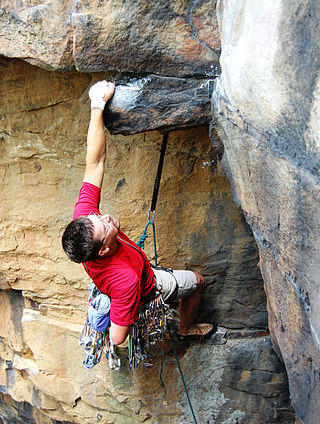
Traditional climbing is a type of free climbing in rock climbing where the lead climber places the protection equipment while ascending the route; when the lead climber has completed the route, the second climber then removes the protection equipment while climbing the route. Traditional climbing differs from sport climbing where the protection equipment is pre-drilled into the rock in the form of bolts.
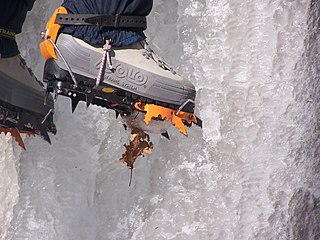
A crampon is a traction device attached to footwear to improve mobility on snow and ice during ice climbing. Besides ice climbing, crampons are also used for secure travel on snow and ice, such as crossing glaciers, snowfields and icefields, ascending snow slopes, and scaling ice-covered rock.

Glossary of climbing terms relates to rock climbing, mountaineering, and to ice climbing.
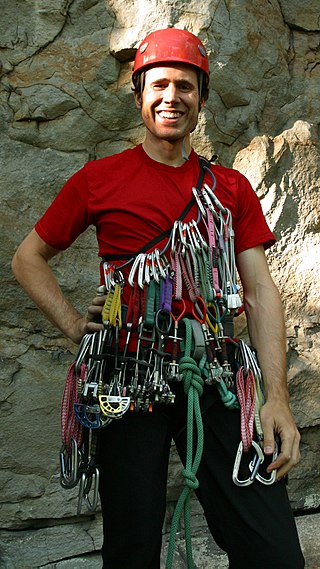
Rock-climbing equipment varies with the specific type of climbing that is undertaken. Bouldering needs the least equipment outside of climbing shoes, climbing chalk and optional crash pads. Sport climbing adds ropes, harnesses, belay devices, and quickdraws to clip into pre-drilled bolts. Traditional climbing adds the need to carry a "rack" of temporary passive and active protection devices. Multi-pitch climbing, and the related big wall climbing, adds devices to assist in ascending and descending fixed ropes. Finally, aid climbing uses unique equipment to give mechanical assistance to the climber in their upward movement.

In climbing and mountaineering, belaying comprises techniques used to create friction within a climbing protection system, particularly on a climbing rope, so that a falling climber does not fall very far. A climbing partner typically applies tension at the other end of the rope whenever the climber is not moving, and removes the tension from the rope whenever the climber needs more rope to continue climbing. The belay is the place where the belayer is anchored, which is typically on the ground, or on ledge but may also be a hanging belay where the belayer themself is suspended from an anchor in the rock on a multi-pitch climb.

Clean climbing is rock climbing techniques and equipment which climbers use in order to avoid damage to the rock. These techniques date at least in part from the 1920s and earlier in England, but the term itself may have emerged in about 1970 during the widespread and rapid adoption in the United States and Canada of nuts, and the very similar but often larger hexes, in preference to pitons, which damage rock and are more difficult and time-consuming to install. Pitons were thus eliminated in North America as a primary means of climbing protection in a period of less than three years.

A piton in big wall climbing and in aid climbing is a metal spike that is driven into a crack or seam in the climbing surface using a climbing hammer, and which acts as an anchor for protecting the climber from falling or to assist progress in aid climbing. Pitons are equipped with an eye hole or a ring to which a carabiner is attached; the carabiner can then be directly or indirectly connected to a climbing rope.
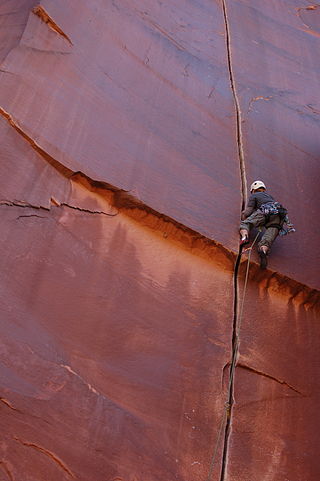
Rock climbing is a climbing sports discipline that involves ascending routes consisting of natural rock in an outdoor environment, or on artificial resin climbing walls in a mostly indoor environment. Routes are chronicled in guidebooks, and on online databases, with the details of how to climb the route, and who made the first ascent and the coveted first free ascent. Climbers will try to ascend a route onsight, however, a climber can spend years projecting a route before they make a redpoint ascent.

An ascender is a device used for directly ascending, or for facilitating protection, with a fixed rope when climbing on steep mountain terrain. A form introduced in the 1950s became so popular it began the term "Jumar" for the device, and the verb "to jumar" to describe its use in ascending.
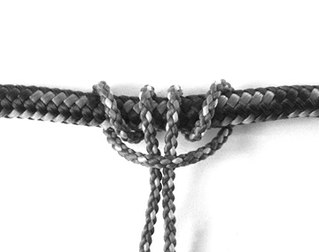
A Prusik is a friction hitch or knot used to attach a loop of cord around a rope, applied in climbing, canyoneering, mountaineering, caving, rope rescue, ziplining, and by arborists. The term Prusik is a name for both the loops of cord used to tie the hitch and the hitch itself, and the verb is "to prusik" or "prusiking". More casually, the term is used for any friction hitch or device that can grab a rope. Due to the pronunciation, the word is often misspelled Prussik, Prussick, or Prussic.
In rock climbing, an anchor can be any device or method for attaching a climber, rope, or load to a climbing surface—typically rock, ice, steep dirt, or a building—either permanently or temporarily. The intention of an anchor is case-specific but is usually for fall protection, primarily fall arrest and fall restraint. Climbing anchors are also used for hoisting, holding static loads, or redirecting a rope.

In climbing, a Tyrolean traverse is a technique that enables climbers to cross a void between two fixed points, such as between a headland a detached rock pillar, or between two points that enable the climbers to cross over an obstacle such as chasm or ravine, or over a fast moving river. Originally developed by Tyrolean mountaineers in the Dolomites in the late 19th to early 20th century, Tyrolean traverses are used in other areas including in caving and in mountain rescue situations.

A belay device is a mechanical piece of climbing equipment used to control a rope during belaying. It is designed to improve belay safety for the climber by allowing the belayer to manage their duties with minimal physical effort. With the right belay device, a small, weak climber can easily arrest the fall of a much heavier partner. Belay devices act as a friction brake, so that when a climber falls with any slack in the rope, the fall is brought to a stop.
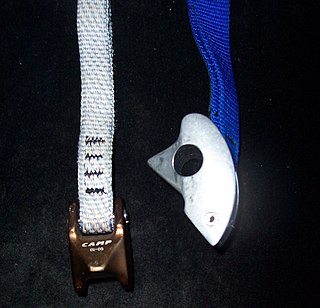
A tricam is a type of climbing protection equipment. A versatile nut/cam hybrid, the Tricam was invented by Greg Lowe in 1973, and came to market in 1981. They are currently manufactured by C.A.M.P. of Premana Italy.
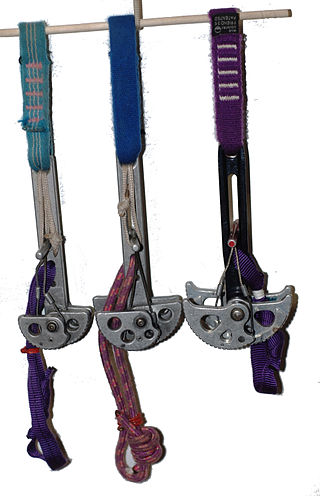
Wild Country is a major manufacturer of rock-climbing equipment, and is most noted for introducing the Friend, a spring-loaded camming device. The company is based in Tideswell in the English Peak District, close to some of the UK's most popular climbing areas.
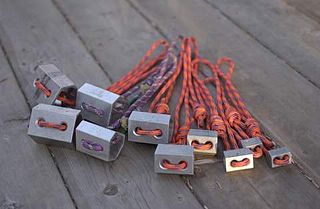
A hex is an item of rock-climbing equipment used to protect climbers from falls. They are intended to be wedged into a crack or other opening in the rock, and do not require a hammer to place. They were developed as an alternative to pitons, which are hammered into cracks, damaging the rock. Most commonly, a carabiner will be used to join the hex to the climbing rope by means of a loop of webbing, cord or a cable which is part of the hex.

The Abalakov thread, also known as a V-thread, A-thread, or 0-thread, is an ice protection technique named after its inventor, Soviet climber Vitaly Abalakov. The Abalakov thread is a common method of protecting oneself while ice climbing because it is easy to create, does not require the sacrifice of expensive gear, and can be very safe when used properly. An Abalakov thread is often used in multi-pitch ice climbing routes. Because of its safety and convenience, the Abalakov thread is considered one of the most significant innovations in ice climbing. It significantly expanded the scope of possible routes and abseiling safety.

Camalot is a brand of spring-loaded camming devices manufactured by Black Diamond Equipment used to secure ropes while rock climbing. Camalots use a dual-axle system, resulting in a slightly higher expansion range than similarly sized single axle units, however that results in significant weight penalty. Dual-axle was patented and for decades was only used by Black Diamond, however the patent has expired in 2005 and several other manufacturers began producing dual-axel cams, often also replicating Camalots sizes and coloring. Most notable Camalot look-alikes include DMM Dragons and Wild Country's New Friends.

In rock climbing, a crack climb is a type of climbing route that follows a system of crack(s) or fissure(s) that the climber uses to ascend the route. The width of the crack dictates the techniques needed, and crack-climbs are further differentiated by the body parts that can be 'jammed' into them, such as finger cracks, hand/fist cracks, arm cracks, and body cracks. Off-width cracks are some of the most awkward, being too wide for the hands or arms, but too narrow to accommodate the body. The rarer top-to-bottom uniform-width crack is called a splitter crack.

Mark Vallance was a British rock climber, mountaineer and founder of Wild Country, a climbing equipment company.





















